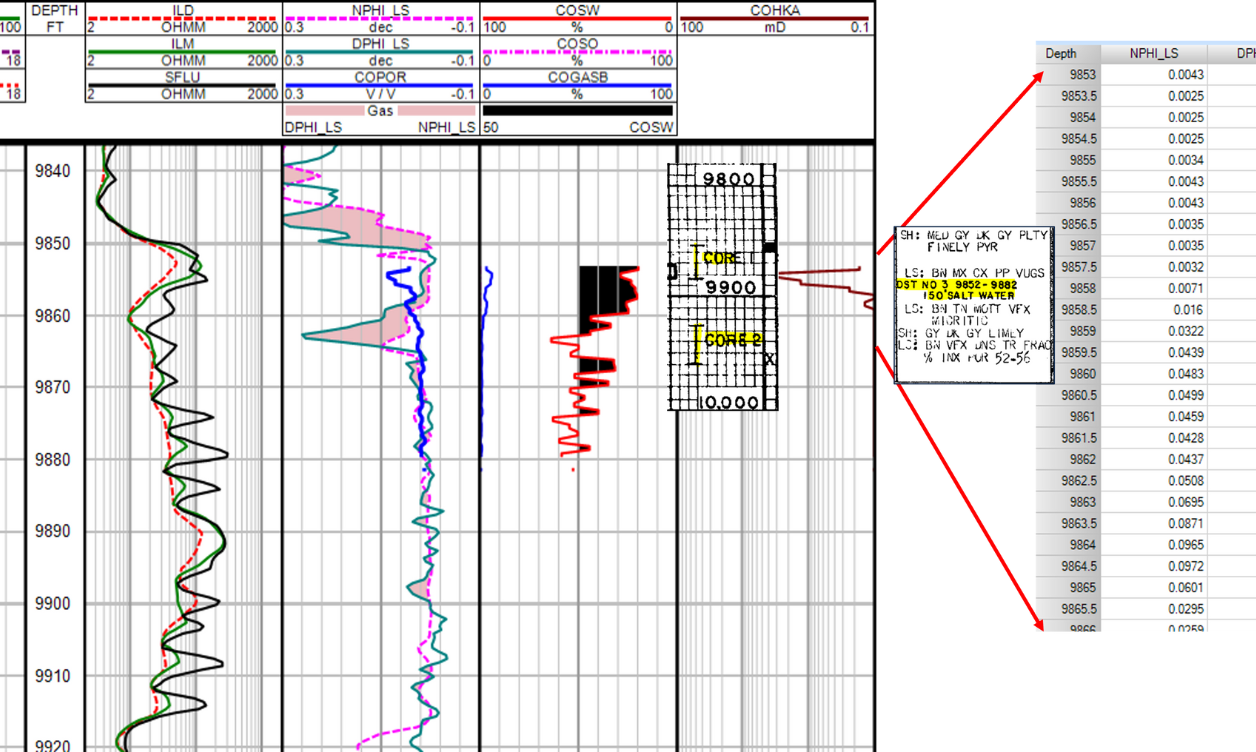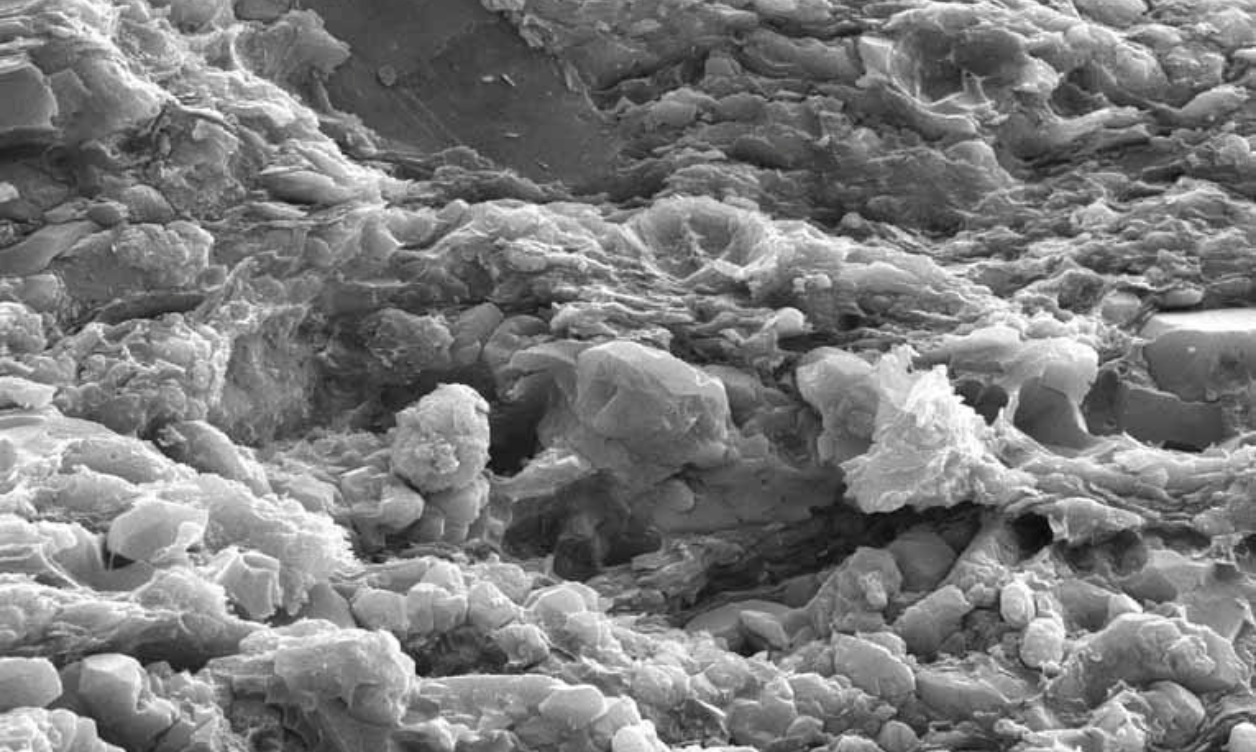Introducing Core Data for Petrophysical Insights
We understand the critical importance of having accurate, reliable ground truth reservoir data. Our core data solution is designed for professionals who require comprehensive petrophysical analysis to make informed decisions in the exploration and development of hydrocarbon reservoirs. Leverage our digitized core analysis reports to enhance the precision and reliability of subsurface data in your projects.

Improving Accuracy with Core Data Interpretation
Core data simplifies the process of loading digitized key attributes captured from hardcopy core analysis reports, making it an essential and invaluable tool for petrophysical log interpretation and modeling. By providing accurate ground truth measurements and calibration points, our core data enhances the reliability, accuracy and efficiency of well log interpretations.
We offer direct measurements of rock properties such as permeability, porosity and lithology. These measurements are used to calibrate the petrophysical log responses and, in logging data, core analysis data can be used to assess the quality of the logging data and identify any potential issues or discrepancies.
Explore Core Data Coverage
The map showcases our core data coverage across the United States, with continuous updates as new data becomes available.
- Ardmore
- Arkoma
- DJ
- Eagleford
- Greater Anadarko
- Greater Permian
- Haynesville
- Illinois
- Las Animas
- Marcellus
- Powder River
- TMS
- Uinta Piceance
- Williston
- Permeability
- Porosity
- Grain Density
- Water/Fluid Saturations
- Hydrocarbon Saturation
- Bulk Density
- Formation Volume Factor (FVF)
- Viscosity
Core Data Product
Explore our extensive and growing repository of core data, sourced from both private donations and public data, which includes standardized key data from core data analysis in an easily consumable CSV format with original source PDF files. We also provide pre-configured templates and technical resources to facilitate seamless data integration within your software program.
%20(6)-1.png)
%20(5).png)
%20(4)-3.png)
Basin-Wide Mapping with Detailed Attributes
Create high-quality basin-wide maps and cross sections with detailed attributes for precise reservoir characterization.
Detailed attributes include:
- Total Organic Carbon
- Organic Thickness
- Facies Distribution
- Original Oil in Place (OOIP)
- Hydrocarbon Pore Volume
- Clay Volume
- Total Porosity
- Total Water Saturation
Identify Key Detailed Attributes
Explore how uncovering key detailed attributes can enhance your reservoir insights, refine landing zone selection and empower strategic decision-making in subsurface analysis.
- Frac barriers and improved completion practices
- Landing zones and lateral placements
- Organic layers
- Key drivers (compare production with petrophysical properties and other subsurface attributes)
-1.png)
Why Choose Core Data?
The primary purpose of completing core analysis on a well is to obtain detailed information about the reservoir rock and fluids. This information is vital for reservoir characterization, reservoir management and production optimization in the oil and gas industry.
Core data supports this and many other valuable tasks:
Well Logging data, when synchronized with core samples retrieved from the wellbore, helps to calibrate and validate the measurements obtained from both sources, significantly enhancing their accuracy and reliability.
Core Analysis is a fundamental and highly accurate method for assessing rock formations in the oil and gas sector, achieved through core drilling at various prospect intervals.
Core analysis helps to provide evidence of the presence, quantity, distribution, and deliverability of hydrocarbons.
Seismic Analysis helps to correlate and validate subsurface geological features. It aids in understanding rock properties and fluid behaviour and enhancing reservoir characterization.
Optimize drilling locations, well placement, and production strategies to increase the efficiency of your hydrocarbon exploration and production.
Pressure Transient Analysis helps estimate reservoir properties such as permeability and skin damage, aiding in reservoir characterization and production optimization.
Help engineers to optimize well placement, injection rates, and production strategies, maximizing hydrocarbon recovery.
Production Data Analysis involves the examination of data generated during the production process.
Identify patterns, trends, and anomalies in the production process to optimize operations, reduce downtime, and make informed decisions.
Fluid Analysis looks at the chemical and physical properties of fluids like oil, coolant, and hydraulic fluid to assess equipment health and performance.
Proactively monitor equipment health, schedule maintenance, and avoid costly downtime.
Petrographic Analysis looks at the composition, texture, and structure of rocks to understand their origin, history, and properties.
Gain valuable insights into geological formations, enabling them to make informed decisions and improve exploration and production efficiency.
Geomechanical Analysis analyzes the mechanical behaviour of geological materials to understand their stability, strength, and deformation properties.
Improve drilling efficiency, reduce operational risks, and enhance the overall safety and performance of their projects.
Specialized Techniques such as, X-ray diffraction, scanning electron microscopy, and fluorescence spectroscopy, provide detailed insights into the mineral composition, pore structure, and fluid properties of rocks.
Enhance your understanding of reservoir characteristics, fluid behaviour, and rock properties to provide more accurate reservoir modeling and improved well planning.
Integrated Analysis is the holistic examination of geological, geophysical, petrophysical, and engineering data to optimize exploration and production activities.
Integrate core data with other datasets, such as seismic, well logs, and production data, to improve reservoir characterization, identify drilling targets, and optimize production strategies.
Get The Data You Need
Core data includes a range of valuable data to help inform drilling decisions.
Porosity is essential for determining a reservoir's storage capacity, indicating the volume of space available for hydrocarbons. It varies significantly across different rock types, affecting how reservoirs are evaluated and developed.
Permeability measures a rock's ability to transmit fluids, essential for understanding how oil and water move through the reservoir. It's influenced by rock texture and structure, directly impacting recovery strategies.
Water Saturation (SW) indicates the portion of the reservoir's pore space filled with water, essential for assessing the available volume for hydrocarbons. It's critical for evaluating reservoir productivity and planning extraction methods.
Hydrocarbon Saturation is key for identifying the amount of oil and gas present, guiding exploration and development decisions by indicating potential production volumes.
Bulk Density provides insights into the rock's mineral composition and porosity, essential for calculating hydrocarbon volumes and assessing reservoir quality.
Grain Density helps in evaluating rock types and their properties, vital for understanding reservoir behavior and estimating hydrocarbon reserves.
Formation Volume Factor (FVF) is vital for converting reservoir conditions to surface conditions, playing a significant role in reservoir management and optimization.
Viscosity is important for understanding fluid flow within the reservoir, influencing recovery techniques and reservoir management strategies by indicating how fluids will behave under various conditions.
%20(3).png?width=1256&height=752&name=Copy%20of%20Website%20Images%20-%20Standard%20image%20size%20(1256%20x%20752)%20(3).png)
Petrophysical Log Interpretation with Core Data
Petrophysical log interpretation is a critical process that involves analyzing data collected by downhole logging tools to determine the physical and chemical properties of subsurface rocks and fluids.
This technique is essential for evaluating reservoir characteristics and the potential for hydrocarbon exploration and production. It relies on core data — actual rock samples from the reservoir — for ground truth measurements, which help calibrate and validate interpretations made from log data. By combining petrophysical log data with core data, experts can gain a detailed understanding of the reservoir's lithology, porosity, permeability and fluid saturations.
This comprehensive approach enhances the accuracy of reservoir models, facilitating more effective drilling and production strategies and leading to more efficient and cost-effective hydrocarbon recovery.
Discover more about how we utilize core data with LAS/LAS+ on our Well Data page.

Core Data for Oil and Gas Professionals
Core data supports people in many roles in the oil and gas sector and beyond.
Analyze the core samples to determine porosity, permeability, and fluid saturations for use in reservoir characterization.
Use the core analysis data to calibrate wireline logs, seismic data, and reservoir models to ensure accuracy.
Assess reservoir connectivity, rock mechanics, and fluid flow behaviour to aid in reservoir management and production optimization.
Characterize the rock properties of oil and gas reservoirs by analyzing the porosity, permeability, and fluid saturations.
Identify flow barriers and plan enhanced oil recovery techniques.
Use core data as an input to reservoir flow models to provide production forecast.
Utilize core data to identify rock types, sedimentary structures and fossil content to better understand the earth’s subsurface and geological history.
Determine the age of rocks, assess geological hazards, and locate oil, gas, and minerals.
Analyze core sample to determine rock strength, lithology, and pore pressure to design drilling programs and select the right drilling fluids/equipment.
Optimize drilling operations and ensure wellbore stability to plan and execute drilling operations safely and efficiently.
Analyze porosity, permeability, and fluid saturations for designing production strategies to identify the most productive zones and plan well completions.
Evaluate reservoir performance, diagnose production issues, and plan reservoir stimulation treatments.
Utilize core data attributes to make strategic decisions about oil and gas assets.
Evaluate reservoir potential, estimate reserves, and plan field development strategies.
Utilize core data to study past environmental conditions and human impacts on the Earth’s surface.
Analyze core data to study geological hazards, assess groundwater resources, and plan remediation efforts for contaminated sites.
Request Sample Data
Interested in a product sample? Let us know your needs and we’ll connect you to the right person on our Well Data Products team.

